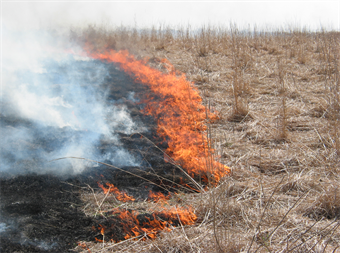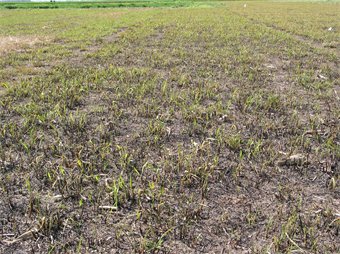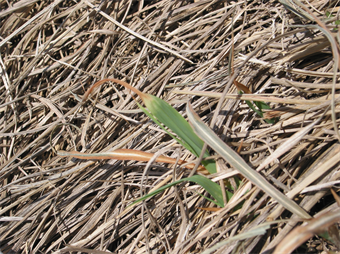1. Introduction
The Great Plains of the central USA are characterized by a continental climate with cold dry winters, hot humid summers, and highly variable weather patterns. The Great Plains were historically temperate grassland ecosystems dominated by the Prairie Parkland and Great Plains Steppe Provinces, each dominated by specifically adapted species [1] . The Prairie Parkland Province of the eastern Great Plains USA is dominated by perennial C4 grasses, including big bluestem (Andropogon gerardii), Indian grass (Sorghastrum nutans), switchgrass (Panicum virgatum), and little bluestem (Schizachyrium scoparium) [1] [2] . The region is characterized by temperature extremes, especially in spring and autumn [1] .
Extreme temperatures during spring and autumn periodically expose living tissues of perennial grasses to a range of high and low temperatures, often within a 24-h period. High temperatures exceeding 37˚C are seldom detrimental to living tissues of C4 grasses. However, living tissues of C4 grasses can be injured by frost and freezing temperatures and grasses can freeze at temperatures as low as −1.5˚C to −2.5˚C [3] . Ambient air temperatures below 0˚C are used frequently to define periods of frost, whereas a hard freeze is identified by ambient air temperatures of −2.2˚C for sufficient time to kill plant tissue [4] (https://www.weather.gov/iwx/fallfrostinfo). Typically, a hard freeze is common in autumn and indicates the conclusion of the growing season [4] . For example, our research experience has demonstrated that a 5-h period of −3.9˚C or below induces autumn dormancy in C4 prairie grasses. However, hard freeze injury to C4 perennial grasses in spring is seldom recognized as a concern. Spring frost damage to C4 turfgrasses such as bermudagrass (Cynodon dactylon) and Zoysia grass (Zoysia spp.) is mentioned in the extension literature [5] , but the literature includes minimal field research information on the C4 perennial prairie grasses native to the Prairie Parkland Province of the Great Plains USA. In a greenhouse study, prairie cordgrass (Spartina pectinata), a C4 perennial prairie grass, was exposed to temperatures as low as −7˚C for up to 3-h and exhibited tolerance to freezing stress [6] . Our objective was to document the damage to field-grown C4 perennial grasses native to the Great Plains USA associated with a naturally-occurring spring hard freeze.
2. Methods
These observations occurred during spring 2004 at the University of Nebraska Eastern Nebraska Research and Extension Center (ENREC) located near Mead, Nebraska USA (Lat. 41˚15', Long. 96˚40'; Elevation 351 m). An automated weather station on site recorded ambient weather conditions on an hourly basis. Weather data were accessed from the High Plains Regional Climate Center website from Weather Station Mead 6S [7] (http://www.hprcc.unl.edu/).
Large production fields, pastures, and small research plots of big bluestem, indiangrass, and switchgrass were burned on 13 April 2004 to remove standing dead material prior to spring growth initiation. Fields of big bluestem, little bluestem, and sand bluestem (Andropogon hallii) were burned to manage weeds and encourage seed production. Application of prescribed fire is a standard management practice that removes standing dead material, suppresses annual weed growth, and increases solar insolation to accelerate spring soil warming to promote rapid early spring C4 grass emergence and growth [8] (Photo 1).
All fields and plots at ENREC were burned on 13 April 2004 and C4 grass emergence occurred rapidly after burning. On 19 April, 6-d after burning, indiangrass was 5-cm tall. On 26 April, 13-d after burning, big bluestem was up to 10-cm tall.
An existing study evaluating the developmental morphology of little bluestem, big bluestem, and sand bluestem fields was compared in 2003 and 2004 to determine the response of plant phenology to this freezing event. In 2003, swards were sampled on July 28 and August 4 from a 0.1 m2 quadrat and hand-clipped to ground level. Sward sampling was repeated in 2004 on July 28 and August 4 to quantify differences between the typical year (2003) and the year with the late-spring hard freeze (2004). Morphology and tiller density were determined for each population. Tillers were morphologically classified to quantify mean stage count (MSC) and tiller density for each species in each year [9] .
3. Observations and Discussion
Beginning on 2 May 2004 at 24:00 pm, air temperature fell below freezing (−0.08˚C) and remained below freezing until 8:00 am on 3 May. Minimum air temperature during this 8-h period was recorded as −2.8˚C at 6:00 am on 3 May. Air temperatures below 0˚C after 1 May at this site commonly occur. Based on data from this weather station during a 50-yr period (1969-2018) from the High Plains Regional Climate Center (Station Mead 6S, NE; http://www.hprcc.unl.edu/), a minimum threshold temperature of 0˚C on or after 3 May occurred 16 times. However, during that same 50-year period, a minimum threshold temperature of −2.8˚C on or after 3 May occurred only twice. Consequently, this was a rare event and our observations captured 1 of the 2 occurrences during the past 50-years.
Exposed plant tissue (leaf lamina) of big bluestem, indiangrass, and switchgrass was injured by a spring hard freeze (Photo 2). Hard freeze-injured switchgrass had a chlorotic appearance as soon as 2-d after freezing temperatures and appeared similar to plants top-killed by herbicide application. Plant injury was manifested by blackening of the terminal 3- to 5-cm of the leaf lamina at 2- to 4-d after freezing. Plants exhibited browning, rolling, and desiccation of this laminar region 14-d after freezing. Hard-freeze injury occurred in both burned and non-burned areas but appeared more extensive on plants that had been burned prior to spring green up. Plant material that was not burned was protected by previous year’s plant litter and avoided injury. However, plant material that had emerged through the litter was damaged by freezing temperatures (Photo 3).

Photo 1. Spring burning big bluestem field on 13 April 2004. Prescribed fire is applied to remove the standing dead material, suppress annual weed growth, and increase solar insolation to promote rapid soil warming and early C4 grass emergence and growth from spring dormancy.

Photo 2. Switchgrass field on 5 May 2004, 2-d after injury by a hard freeze. This field was burned on 13 April 2004, grew rapidly for 19-d, and was exposed to freezing temperature of −2.8˚C on 3 May. Plants had a similar appearance to plants that have been top-killed by herbicides. This field was planted in 1998 and was still in production in 2018.

Photo 3. Plant residue on the soil surface protected leaf tissue from damage by a spring hard freeze. Note the dead tissue at the leaf tip that had emerged from the residue and was exposed to freezing temperature of −2.8˚C on 3 May. This photo was taken on 6 May 2004, 3-d after exposure to freezing temperatures.
Measuring plant response to infrequent, extreme environmental events cannot be quantified since there is no way to design a replicated field experiment to test a hypothesis. However, relative indicators can provide insight into plant response to these environmental anomalies. We used the morphology and tiller density data from 2003 and 2004 to evaluate this anomaly (Table 1). Based on the developmental morphology data, no clear differences in plant phenology occurred between 2003 and 2004. Between 2003 and 2004, the MSC for little bluestem and sand bluestem declined slightly in July but increased slightly in August. For big bluestem, the MSC did not vary across years. However, tiller density increased in July and August for all species from 2003 to 2004, except for little bluestem in August (Table 1). This increase in tiller density in 2004 clearly indicates that tiller survival was not negatively affected by the freezing temperatures in May 2004.
During the 2004 growing season, field notes were kept on the general plant appearance and growth and development of the C4 grasses.
June 16: “Cattle began grazing indiangrass pastures.”
July 13: “The indiangrass pastures look great.”
July 22: “The farm cut 16 round bales from the remaining 1-ha of big bluestem.”
July 28: “Pawnee big bluestem is just entering anthesis, with 47% of the tillers in reproductive stages. Little bluestem has 60% of the tillers in the boot stage.”
August 2: “Moved cattle off the indiangrass pastures.”
August 20: “The indiangrass pastures are re-growing and advancing nicely. Pawnee big bluestem is past peak anthesis.”
These field notes indicate nothing out of the ordinary for the C4 grasses. A long-term bioenergy evaluation of “Cave-in-Rock” switchgrass biomass across multiple harvest and fertilizer treatments had average annual yields of 8.0, 5.8, 7.2, and 7.6 Mg ha−1 in 2001, 2002, 2003, and 2004, respectively. All the important agronomic and livestock responses, including grazing readiness, plant morphology, tiller demographics, livestock performance, and biomass yield were all within normal ranges for environmental variation for these C4 grasses.
![]()
Table 1. Comparison of morphological development of little bluestem, big bluestem, and sand bluestem in eastern Nebraska, USA in 2003 and 2004. Plants in 2003 were exposed to typical spring temperatures, whereas plants in 2004 were exposed to freezing temperatures on May 3. Morphology and tiller density were quantified on July 28 and August 4, 2003 and 2004.
It is important to differentiate between spring frost and a hard spring freeze. As indicated previously, a minimum threshold temperature of 0˚C (frost) on or after 3 May is common, occurring 16 times in a 50-year period. However, a minimum threshold temperature of −2.8˚C (hard freeze) on or after 3 May occurred only twice in that same 50-year period. A spring hard freeze is an environmental anomaly at this location.
4. Conclusions
This is the first field documentation of the response of multiple species of C4 prairie grasses to a spring hard freeze following considerable spring growth. The spring hard freeze caused visible plant injury to little bluestem, big bluestem, sand bluestem, indiangrass, and switchgrass immediately following the hard-freeze event in 2004. Plant response to the hard freeze appeared similar to an early-spring application of a non-selective herbicide, but negative responses were short-lived. Plant injuries resulting from the hard freeze were temporary and plants rapidly overcame the freezing incident. Injuries resulting from freezing temperatures were not visible 3-weeks after the freezing event. Tiller survival was not negatively affected by the freezing temperatures in May 2004 as evidenced by increased tiller densities from 2003 to 2004 for little bluestem, big bluestem, and sand bluestem. Plant recovery to this spring hard freeze further demonstrates the ecological resilience of these C4 prairie grasses to non-predictable weather events. We conclude that these rare spring hard freezes have short-term impacts on C4 grasses, but do not negatively affect agronomic performance for forage or bioenergy later in the growing season or long-term survival. Consequently, breeding for early spring emergence and growth in perennial C4 grasses native to the Great Plains USA should not increase the risk of stand failure due to exposure to early spring freezing stress.
The USDA prohibits discrimination on the basis of race, color, national origin, age, disability, and where applicable, sex, marital status, familial status, parental status, religion, sexual orientation, genetic information, political beliefs, reprisal, or because all or part of an individual’s income is derived from any public assistance program. Mention of trade names or commercial products in this publication does not imply recommendation or endorsement by the USDA. USDA is an equal opportunity employer. Funding to complete this research was provided by USDA-ARS.